
![Ver [Langton, W.; 1876] en referencias bibliográficas. Libro abierto, hojas de plata, filo de oro, guardas de gules, tapas de sable.](../css/Libro.Bibliografia.png)
Langton, W.; 1876
William Langton, «The Visitation of Lancashire and a part of Cheshire, made in the twenty-fourth year of the reign of King Henry the Eighth, A.D. 1533, by special commission of Thomas Benolte (Benalt), Clarencieux», Chetham Society, Manchester, 1876.
In 1876 the first part of this book was published and in 1882 the second part. The cover of the book refers to «Thomas Benalt», but it might actually be «Thomas Benolte» or «Thomas Benolt»
Bibliographical reference of century XIX.
The author is Langton, William.
External resources:


![Ver [Royal Spanish Academy] en instituciones citadas. Fortaleza de oro y mazonada de sable.](../css/Fortaleza.Institucion.png)
Royal Spanish Academy

Emblem of the Royal Spanish Academy
Emblemb Argent, a crucible Argent, enflamed and on a bonfire hoguera Gules and Or.
Emblema de plata, un crisol de plata, llameante y sumado a una hoguera de gules y oro.
Painted by me with a raised-stroke finish, with an oval shape and with a thin golden edge around it which is purely ornamental.
The Royal Spanish Academy, also known by its acronym RAE, is made up of 46 full members, all elected for life to occupy seats designated by letters of the Spanish alphabet.
In addition to the full members, the Royal Spanish Academy also has corresponding members and other associated members, which completes its structure as the main regulatory institution of the Spanish language.
Categories: Institution, Interpreted, Socioeconomic, Oval, Illuminated, Outlined in sable, Freehand, Emblem, Without divisions, Argent, One, Crucible, Enflamed, Bonfire, Gules and Or.


Royal Spanish Academy, coat of arms
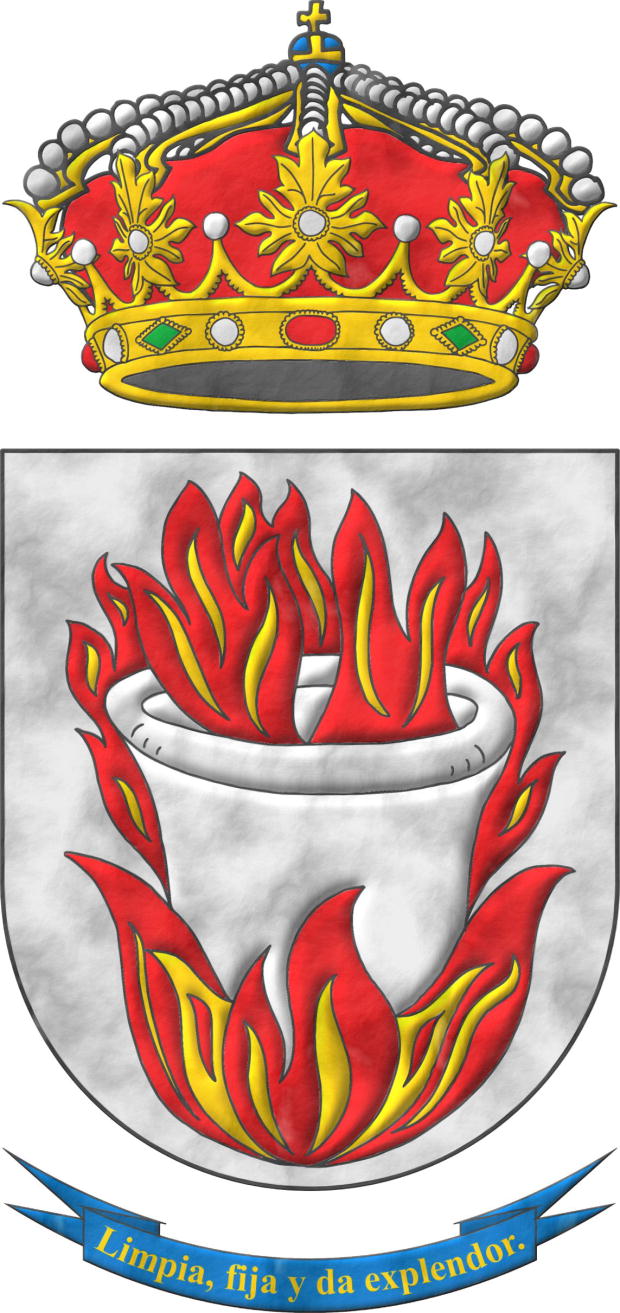
Argent, a crucible Argent, enflamed and on a bonfire hoguera Gules and Or. Crest: A closed royal crown Or, with eight arches, visible five. Motto: «Limpia, fixa, y da esplendor» Or over a scroll Azure.
Escudo de plata, un crisol de plata, llameante y sumado a una hoguera de gules y oro. Timbrado de una corona real cerrada. Lema: «Limpia, fixa, y da esplendor» de oro sobre una filacteria de azur.
Interpretation made from the Royal Academy emblem: transforming it into a semicircular-based shield, instead of its oval shape; with its motto on a scroll beneath the base, instead of surrounding it; keeping the closed royal crown in its place; with everything illuminated except the field which is in plain color; and the whole outlined in sable and with a parchment-like finish.
In this interpretation, on the Argent field, the Gules fire of the bonfire completely surrounds the Argent crucible, to avoid the metal Argent on the same.
To write the blazon for this coat of arms I use the heraldic term «llameante». Therefore, I do not follow [Avilés, J.; 1780a; page 82 and figure 163] when he writes «...y un Fénix de gules sobre una hoguera encendida de lo mismo.». He uses this example to illustrate the 2 fundamental uses of the term «encendido» which is said when «the Eyes of animals... are of a different color» and «also of a burning Bush and the same for a Torch, when the flame is of a different tincture».
Blazon keywords: Without divisions, Argent, One, Crucible, Enflamed, Bonfire, Gules, Or, Closed royal crown, Crown, Motto, Scroll and Azure.
Style keywords: Semi-circular, Illuminated, Outlined in sable and Parchment.
Classification: Interpreted, Socioeconomic and Coat of arms.
Bearer: Royal Spanish Academy.


Royal Spanish Academy, emblem
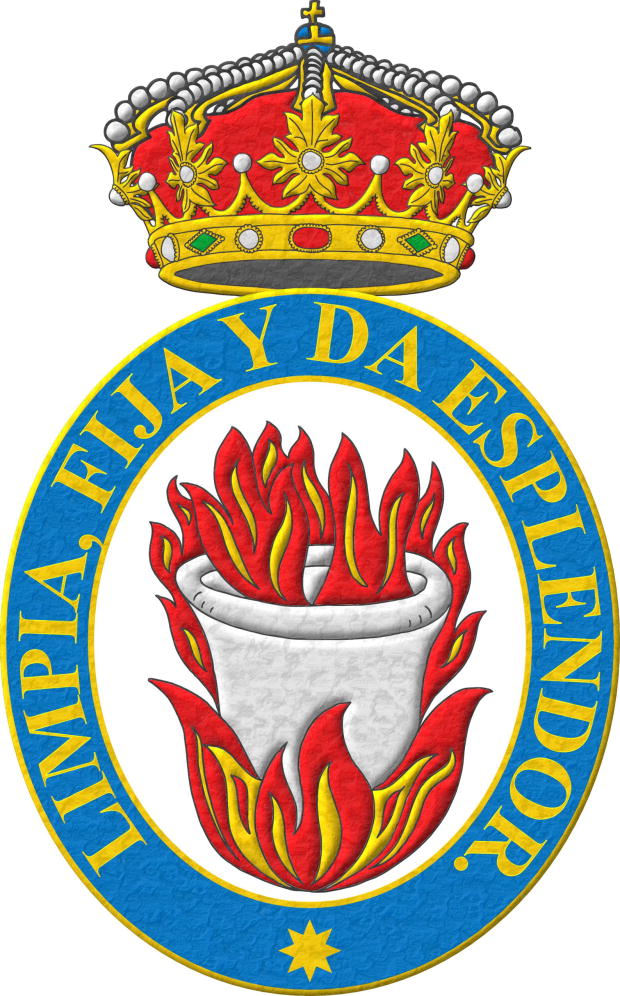
Emblemb Argent, a crucible Argent, enflamed and on a bonfire hoguera Gules and Or. Crest: A closed royal crown Or, with eight arches, visible five. Motto around the shield: «Limpia, fixa, y da esplendor» Or over a scroll Azure, fimbriated Or.
Emblema de plata, un crisol de plata, llameante y sumado a una hoguera de gules y oro. Timbrado de una corona real cerrada. Lema alrededor del escudo: «Limpia, fixa, y da esplendor» de oro sobre una filacteria de azur, perfilada de oro.
Painted by me with a metalwork finish, with an oval shape.
The Royal Spanish Academy was founded in 1713 on the initiative of Juan Manuel Fernández Pacheco, eighth Marquess of Villena and Duke of Escalona, with the aim of «fixing the words and vocabulary of the Castilian language in its greatest propriety, elegance, and purity». A year later, in 1714, its creation was approved by a Royal Decree of Philip V.
To symbolize its purpose, its emblem with a crucible to the fire and its motto «Limpia, fija y da esplendor» [Zamora Vicente, A.; 1999] were chosen by secret ballot. In some old versions of this emblem the motto can be read with the term «fixa» and a comma before the conjunction, that is, «Limpia, fixa, y da esplendor».
This article is illustrated with my personal interpretation of this emblem of the Royal Spanish Academy, crested with a closed royal crown of 8 arches, of which the 5 frontal ones are completely visible.
In this, as in any of my works, I always consult its dictionaries, almost as much, as the most interesting and specific works on the subject of study.
Blazon keywords: Without divisions, Argent, One, Crucible, Enflamed, Bonfire, Gules, Or, Closed royal crown, Crown, Motto, Within, Scroll, Azure and Fimbriated.
Style keywords: Oval, Illuminated and Outlined in sable.
Classification: Interpreted, Socioeconomic, Metalwork and Emblem.
Bearer: Royal Spanish Academy.


![Ver [Rylands, J. P.; 1882] en referencias bibliográficas. Libro abierto, hojas de plata, filo de oro, guardas de gules, tapas de sable.](../css/Libro.Bibliografia.png)
Rylands, J. P.; 1882
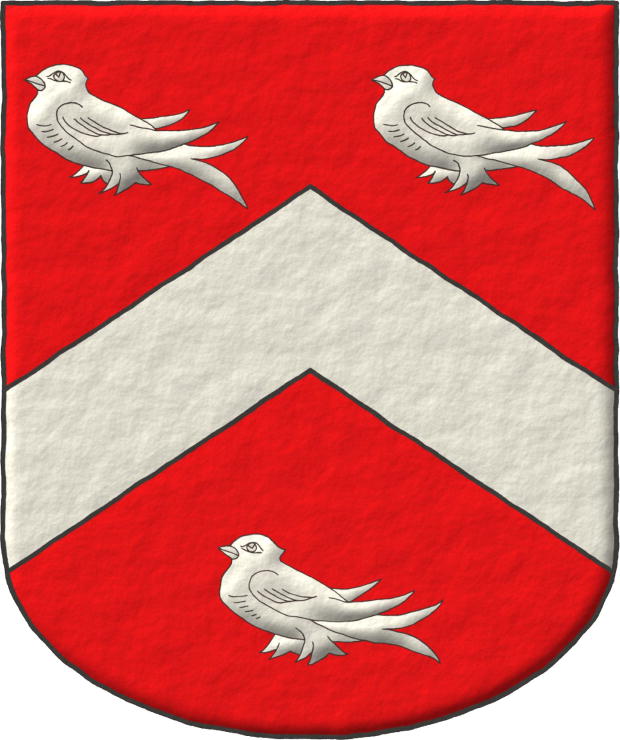
John Paul Rylands, «The Visitation of Cheshire in the Year 1580, Made by Robert Glover, Somerset Herald, for William Flower, Norroy King of Arms, with Numerous Additions and Continuations, Including those from The Visitation of Cheshire in the Year 1566, by the same Herald, with an Appendix Containing The Visitation of a Part of Cheshire in the Year 1533, William Fellows, Lancaster Herald, for Thomas Benolte, Clarenceux King Of Arms, And a Fragment of The Visitation of the City of Chester in the Year 1591, Made by Thomas Chaloner, Deputy to the Office Of Arms», edited by John Paul Rylands, F. S. A., published by The Harleian Society, London, 1882.
[Goldstraw, M. S. J.; 2013a] es una recreación a color de los escudos registrados en este libro.
El escudo que ilustra esta referencia bibliográfica es uno de los que se registran en este libro y corresponde al escudo de Tatton de Wythenshawe, con la diferencia que aquí no se ha incluido su timbre.
Bibliographical reference of century XIX.
Author: Rylands, John Paul.
The following article cites this bibliographic reference:


Flor, Roger de
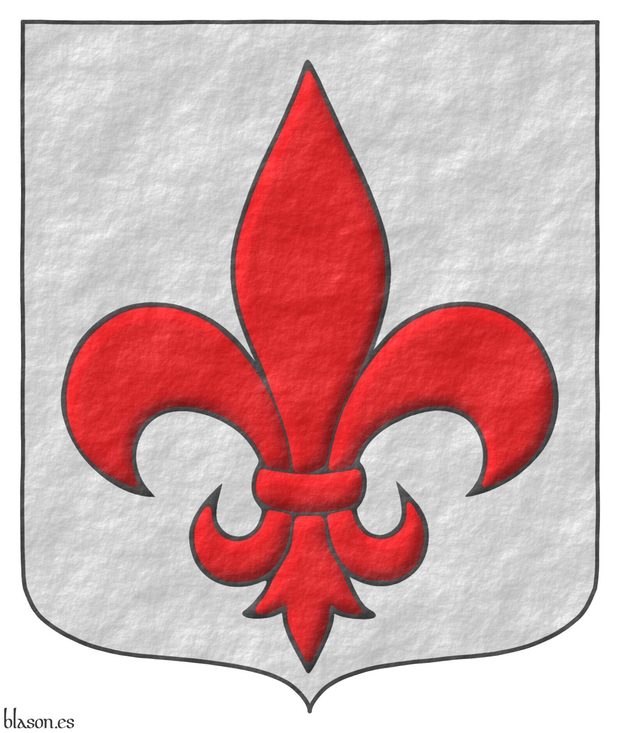
Leader of the almogávares in the service of the Crown of Aragon, born in Brindisi, southeast Italy, in 1266, and assassinated in Adrianople, European Turkey, in 1305.
Argent, a fleur de lis Gules.
Escudo de plata, una flor de lis de gules.
Coat of arms interpreted with: the pointed and rounded form; the field in flat Argent; the fleur de lis illuminated in Gules and outlined in Sable; and an overall rough finish.
Blazon keywords: Without divisions, Argent, Gules and Fleur de lis.
Style keywords: Ogee, Illuminated, Outlined in sable and Rough.
Classification: Interpreted, Personal, Army and Navy and Coat of arms.
Bearer: Flor, Roger de.


Roger de Flor
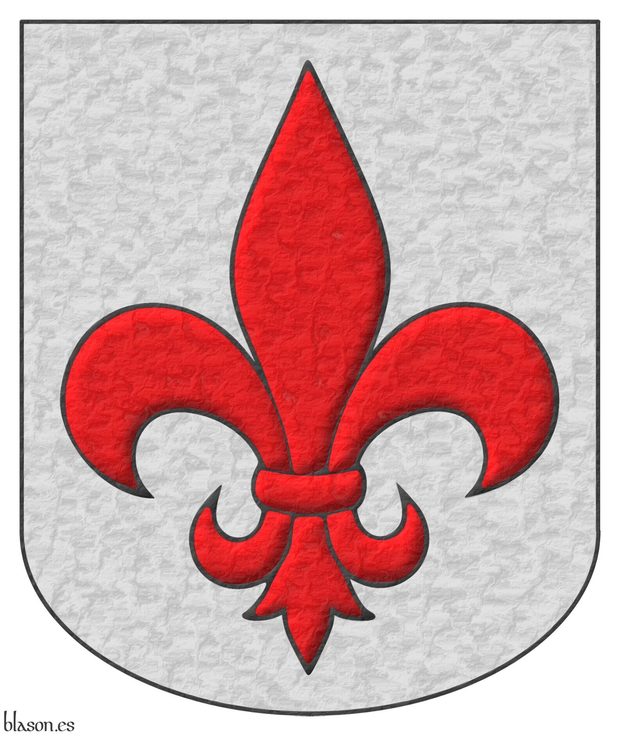
The 1st Flag of the Spanish Army Paratrooper Brigade bears his name and his coat of arms.
Argent, a fleur de lis Gules.
Escudo de plata, una flor de lis de gules.
Coat of arms interpreted with: a rounded base; a fleur de lis illuminated in Gules and outlined in Sable; and an overall lightly-hammered metal finish.
Blazon keywords: Without divisions, Argent, Gules and Fleur de lis.
Style keywords: Rounded, Illuminated, Outlined in sable and Soft metal.
Classification: Interpreted, Personal, Army and Navy and Coat of arms.
Bearer: Flor, Roger de.


BPAC I
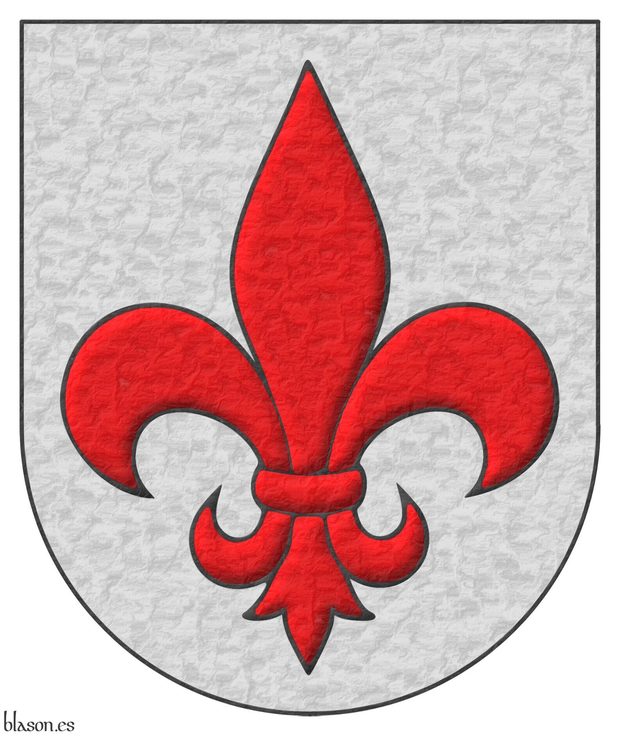
Flag «Roger de Flor», Paratroopers I, assigned to the «Almogávares» VI Paratrooper Brigade of the Spanish Army.
Argent, a fleur de lis Gules.
Escudo de plata, una flor de lis de gules.
Coat of arms interpreted with: a semicircular (round) base; a fleur de lis outlined in Sable and illuminated in Gules; and an overall lightly-hammered metal finish.
Blazon keywords: Without divisions, Argent, Gules and Fleur de lis.
Style keywords: Semi-circular, Illuminated, Outlined in sable and Soft metal.
Classification: Interpreted, Military, Army and Navy and Coat of arms.
Bearer: BPAC I.

Continue with: BPAC, Roger de Flor II.
-
Language
-
Categories of heraldry
-
Divisions of the field
- Without divisions
- Party per pale
- Party per fess
- Party per bend
- Party per bend sinister
- Tierce
- Tierce sinister
- Tierced per pale
- Tierced per fess
- Tierced per bend
- Tierced pallwise inverted
- Quarterly
- Quarterly per saltire
- Gyronny
- Party per fess, the chief per pale
- Party per pale, the sinister per fess
- Party per fess, the base per pale
- Party per pale, the dexter per fess
- Chapé
- Chaussé
- Embrassé
- Contre-embrassé
- Party per chevron
- Enté
- Enté en point
- Flanched
-
Metals
-
Colours
-
Furs
-
Other tinctures
-
Ordinaries and sub-ordinaries
-
Diminutives of the ordinaries
-
Geometric charges
-
Composite ordinaries
-
Inanimate charges from Nature
Atom, Crescent, Diamond, Emerald, Estoile, Increscent, Lightning flash, Moon, Mount, Mullet, Mullet of four points, Orbital, Plough of Ursa Major, Rainbow, Ray of the sun, River, Sea, Snowflake, Sun, Sun in splendour, Sun of May, Trimount, Water and Wave.
-
Vegetal charges from Nature
Acorn, Apple, Apple tree, Ash, Bluebonnet, Camellia, Chrysanthemum, Cinquefoil, Cornflower, Dogwood flower, Double rose, Elm, Fleur de lis, Flower, Gourd, Holm oak, Hop cone, Kapok tree, Laurel, Lily, Linden, Lotus flower, Madonna lily, Mexican cedar tree, Oak, Olive tree, Palm tree, Plantain plant, Pomegranate, Poplar leaf, Rose, Shamrock, Sunflower, Thistle, Tree, Tulip, Vine and Wheat.
-
Animal charges from Nature
Badger, Bald eagle, Barbel, Barn owl, Bear, Beaver, Beetle, Bighorn sheep, Blackbird, Boar, Brach hound, Bull, Doe, Dog, Dolphin, Dove, Eagle, Elephant, Falcon, Female figure, Fish, Flame, Fly, Fox, Frog, Goat, Goldfinch, Goose, Heron, Horse, Hummingbird, Jaguar, Lark, Leopard, Lion, Lion passant, Lion rampant guardant, Lioness, Lynx, Male figure, Martlet, Merino ram, Owl, Panther, Parrot, Peacock, Pelican, Pelican in her piety, Puffin, Quetzal, Raven, Roe deer, Rooster, Savage, Seagull, Serpent, She-wolf, Stag, Starling, Talbot, Tyger, Vulture, Warren hound and Wolf.
-
Parts of natural charges
Arm, Beak, Branch, Caboshed, Chest, Claw, Covert, Dorsal fin, Eagle claw, Ermine spot, Escallop, Feather, Foot (palmiped), Foreleg, Forepaw, Hand, Head, Heart, Hoof, Leaf, Neck, Ostrich feather, Palm frond, Paw, Roe deers' attires, Shoulder, Sprig, Stags' attires, Stem, Swallow-tail, Tail, Tail addorsed, Tail fin, Talon, Tooth, Trunk, Trunk (elephant), Two hands clasped, Two wings in vol, Udder, Wheat spike, Wing and Wrist.
-
Artificial charges
Ace of spades, Anchor, Anvil, Arch, Arm vambraced, Armillary sphere, Arrow, Axe, Bell, Bell tower, Beret, Bonfire, Book, Bookmark, Bow, Branding iron, Bridge, Broken, Buckle, Cannon, Cannon dismounted, Cannon port, Canopy roof, Carbuncle, Castle, Celtic Trinity knot, Chain, Chess rooks, Church, Clarion, Clay pot, Closed book, Club, Column, Comb, Compass rose, Conductor's baton, Cord, Covered cup, Crozier, Crucible, Cuffed, Cup, Cyclamor, Dagger, Double vajra, Drum, Ecclesiastical cap, Fanon, Federschwert, Fleam, Four crescents joined millsailwise, Galician granary, Garb, Gauntlet, Geometric solid, Grenade, Halberd, Hammer, Harp, Host, Hourglass, Key, Key ward, Knight, Knot, Lantern, Letter, Line, Loincloth, Menorah, Millrind, Millstone, Millwheel, Monstrance, Mortar, Mullet of six points pierced, Nail, Non-classic artifact, Norman ship, Number, Oar, Oil lamp, Open book, Page, Pair of scales, Parchment, Pestle, Piano, Pilgrim's staff, Plough share, Polish winged hussar, Port, Portcullis, Potent, Quill, Ribbon, Rosette of acanthus leaves, Sabre, Sackbut, Sail, Scroll, Scythe, Sheaf of tobacco, Ship, Skirt, Spear, Spear's head, Stairway, Star of David, Step, Sword, Symbol, Tetrahedron, Torch, Tower, Trident, Trumpet, Turret, Two-handed sword, Wagon-wheel, Water-bouget, Wheel, Winnowing fan and With a turret.
-
Immaterial charges
Angel, Archangel, Basilisk, Dragon, Dragon's head, Garuda, Golden fleece, Griffin, Heart enflamed, Justice, Mermaid, Our Lady of Mercy, Ouroboros, Paschal lamb, Pegasus, Phoenix, Sacred Heart of Jesus, Saint George, Sea-griffin, Trinity, Triton, Unicorn, Winged hand and Wyvern.
-
External elements
-
Heraldic creations
-
References
-
Formats
-
Keywords on this page
Between, Parchment, Azure, BPAC I, Bibliography, Chevron, Cheshire County, Ogee, Crown, Closed royal crown, Crucible, Quarterly, Outlined in sable, Within, Motto (identification), Army and Navy, Emblem, Coat of arms, Scroll, Fleur de lis, Flor, Roger de, Personal, Gules, Bonfire, Illuminated, Institution, Interpreted, Metalwork, Motto, Enflamed, Martlet, Semi-circular, Soft metal, Military, Ordered, Or, Oval, Fimbriated, Argent, Without divisions, Rounded, Royal Spanish Academy, Rough, Century XIX, Socioeconomic, Freehand and One.
